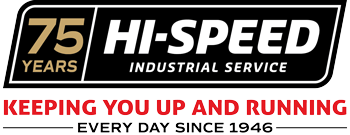Like many other industries, one of the simplest ways to increase productivity is to motorize the tools and devices used by the workers.
- Hand saw vs circular saw
- Sandpaper vs electric sander
- Bit & brace vs electric or cordless drill
The same holds true as the machinery and tools increase in size and strength. A manual overhead crane might be the best choice for you in certain instances, such as small loads and tight spaces. But as the workload increases in frequency and weight, a motorized overhead crane quickly becomes the superior option. Today we’ll discuss the benefits of motorizing your overhead crane systems to help you decide the best choice for your business.
Motorizing Your Existing Overhead Crane
The first step is determining whether your overhead crane supports a motor option. Due to the original design and manufacture, your overhead crane may require structural upgrades to handle the added weight and increased load size that motorization provides.
Jib cranes, including most wall-mounted, freestanding, and mast style versions can be motorized.
Gantry cranes can provide high-capacity ground travel with motors installed at the casters.
Workstation cranes with a capacity of 1,000 pounds or more can typically motorize the trolley and bridge assembly.
All motorized drive enclosures should meet NEMA 4 standards. This standard assures that the housing won’t allow cutting fluid or water from cleaning procedures to enter the housing. Typically, NEMA 4 housings incorporate self-lubricating bearings to reduce maintenance and replacement costs further.
Lastly, because the motors require a variety of voltages, motorizing your crane requires a certified industrial electrician familiar with 60Hz and 3-phase power sources. Incorrect connections can result in short-circuiting, damaging the other internal components and the motherboard.
Disclaimer: Always consult with an overhead crane expert before motorizing your crane. Failure to do so can result property damage, personal injury, or loss of life by creating an unsafe work environment.
To learn more about motorized options, you can email the Hi-Speed Overhead Crane Experts, or you can call us direct at 1-800-713-0103 with your crane motorization questions.
Crane Motor Options: Single-Speed or 2-Speed?
Single-speed motors – Once the button gets pushed, the motor accelerates as fast as possible, depending on the load weight and size. Upon releasing the controller, the brakes will set, stopping the crane travel. If your single-speed motor operates at 50 FPM (Feet Per Minute), that’s the only operating speed available.
2-speed motors – Provide two different operational speeds, usually established with a 3:1 ratio. As a result, a 2-speed crane can operate at either 30 FPM or 90 FPM, depending on which button the operator presses. Once the button gets released, the brakes engage to stop the crane’s movement.
A Reduced Voltage Starter (“Soft Start Technology”) can reduce startup acceleration, lowering the torque applied to the crane’s overhead drivetrain assembly for lower duty cycles. Unfortunately, soft start technology produces excessive heat and is not recommended for high-use or high-duty cycle applications.
Crane Motor Options: Wound Rotor or DC Controls?
As the name implies, the wound rotor travels in and out to engage/disengage with the slip rings, followed by the brushes, before finally connecting to the banks of resistors. The operator can control the motor acceleration by adjusting the resistance of the motor rotor. While wound rotor systems work exceptionally well, due to their complexity and the amount of wiring required, they can be challenging to troubleshoot and repair.
DC controls are standard on high-duty cycle cranes, as they provide more options and controls to the operator to control the crane’s starting, stopping, and speed. DC crane controls are just as complicated as their wound motor counterparts but remain popular for mills and assembly line facilities today.
Overhead Crane Motor Options: What are Variable Frequency Drives?
Variable Frequency Drives (VFD) change the voltage and frequency received by the motor to make the speed and other controls more adjustable. By changing the speed, the operator can create acceleration and deceleration ramps, prolonging brake life. And unlike DC controls, overheating risks are virtually eliminated for high-use Class D, Class E, and Class F process cranes because VFD changes the frequency and voltage.
More economical VFD systems can typically incorporate 30-50 programmable parameters for virtually any type of crane application. Higher-end VFD systems can handle up to 300 programable parameters, including the bridge, trolley, hoist, and hook controls.
If you deal regularly with imbalanced or difficult-to-access loads, motorizing your crane will provide your employees with a safer and more efficient workspace while increasing productivity.
Motorizing your overhead crane will provide smoother controls, making lifts and travel easier and faster. Better control increases worker safety, especially if you consistently work with hazardous materials or a congested workspace.
To learn more about motorized crane options, you can email the Hi-Speed Overhead Crane Experts, or you can call us direct at 1-800-713-0103 with your crane motorization questions.

